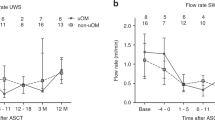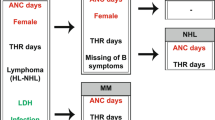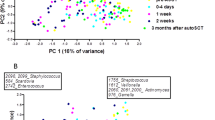Abstract
The underlying mechanism of high-dose therapy (HDT)-related oral mucositis (OM) may be partly mediated by alterations in the normal salivary composition. This study evaluated salivary antioxidant and immunological capacities observed in myeloma patients suffering from HDT-related OM, and assessed potential contribution of these factors to OM development. Twenty-five consecutive myeloma patients treated with melphalan 200 mg/m2 followed by autologous SCT were enrolled. Patients underwent a daily assessment for OM, and salivary samples were collected on days −3 and +7 of transplantation and analyzed for secretory IgA and antioxidant capacity. The degree of mucosal damage was assessed by measuring the salivary carbonyl and albumin (Alb) levels. OM, reported in 96% of patients, appeared to be most severe on 8 day after transplantation (range: +2 to +14). Clinical mucositis was associated with significant reduction in salivary secretory IgA (54%; P=0.05), and antioxidant activity, measured by total antioxidant status (40%; P=0.0004), antioxidant capacity (ImAnOx) (23%; P=0.002) and uric acid level (51%; P=0.006). The increase found in salivary Alb (119%; P=0.024) and carbonyl (28%; P=0.047) levels, indicates mucosal and oxidative damage, respectively. These salivary changes might enhance mucositis development and symptoms. Therapeutic interventions, enhancing antioxidative and immunological activities need to be investigated.
This is a preview of subscription content, access via your institution
Access options
Subscribe to this journal
Receive 12 print issues and online access
$259.00 per year
only $21.58 per issue
Buy this article
- Purchase on Springer Link
- Instant access to full article PDF
Prices may be subject to local taxes which are calculated during checkout



Similar content being viewed by others
References
Barlogie B, Shaughnessy J, Tricot G, Jacobson J, Zangari M, Anaissie E et al. Treatment of multiple myeloma. Blood 2004; 103: 20–32.
Attal M, Harousseau JL, Facon T, Guilhot F, Doyen C, Fuzibet JG et al. Intergroupe Francophone du Myelome. Single versus double autologous stem cell transplantation for multiple myeloma. N Engl J Med 2003; 349: 2495–2502.
Copelan EA . Hematopoietic stem cell transplantation. N Engl J Med 2006; 354: 1813–1826.
McGuire DB, Altomonte V, Peterson DE, Wingard JR, Jones RJ, Grochow LB . Patterns of mucositis and pain in patients receiving preparative chemotherapy and bone marrow transplantation. Oncol Nurs Forum 1993; 20: 1493–1502.
Sonis ST . Pathobiology of oral mucositis: novel insights and opportunities. J Support Oncol 2007; 9 (Suppl 4): 3–11.
Bellm LA, Epstein JB, Rose-Pad A, Martin P, Duchs HJ . Patient reports of complications of bone marrow transplantation. Support Care Cancer 2000; 8: 33–39.
Garfunkel AA . Oral mucositis—the search for a solution. N Engl J Med 2006; 351: 2649–2651.
Rubenstein EB, Peterson DE, Schubert M, Keefe D, McGuire D, Epstein J et al. Clinical practice guidelines for the prevention and treatment cancer therapy-induced oral and gastrointestinal mucositis. Cancer 2004; 100 (Suppl 9): 2026–2046.
Blijlevens N, Schwenkglenks M, Bacon P, D’Addio A, Einsele H, Maertens J et al. Prospective oral mucositis audit: oral mucositis in patients receiving high-dose melphalan or BEAM conditioning chemotherapy—European Blood and Marrow transplantation mucositis advisory group. J Clin Oncol 2008; 26: 1519–1525.
Micozzi A, Cartoni C, Monaco M, Martino P, Zittoun R, Mandelli F . High incidence of infectious gastrointestinal complications observed in patients with acute myeloid leukemia receiving intensive chemotherapy for first induction of remission. Support Care Cancer 1996; 4: 294–297.
Sonis ST, Elting LS, Keefe D, Peterson DE, Schubert M, Hauer-Jensen M et al. Mucositis study section of the multinational association for supportive care in cancer; International Society for Oral Oncology.Perspectives on cancer therapy-induced mucosal injury: pathogenesis, measurement, epidemiology, and consequences for patients. Cancer 2004; 100: 1995–2025.
Harrison T, Bigler L, Tucci M, Pratt L, Malamud F, Thigpen JT et al. Salivary sIgA concentrations and stimulated whole saliva flow rates among women undergoing chemotherapy for breast cancer: an exploratory study. Spec Care Dentist 1998; 18: 109–112.
Dens F, Boogaerts M, Boute P, Declerck D, Demuynck H, Vinckier F . Quantitative determination of immunological components of salivary gland secretion in transplant recipients. Bone Marrow Transplant 1996; 17: 421–423.
Biron P, Sebban C, Gourmet R, Chvetzoff G, Philip I, Blay JY . Research controversies in management of oral mucositis. Support Care Cancer 2000; 8: 68–71.
Nagler R, Hershkovich O, Lischinsky S, Diamond E, Reznick AZ . Saliva analysis in the clinical setting: revisiting an underused diagnostic tool. J Investig Med 2002; 50: 214–225.
Mancini G, Carbonara AO, Heremans JF . Immunochemical quantitation of antigens by single radial immunodiffusion. Immunochemistry 1965; 2: 235–254.
Pruitt KM, Kamau DN, Miller K, Mansson-Rahemtulla B, Rahemtulla F . Quantitative, standardized assays for determining the concentrations of bovine lactoperoxidase, human salivary peroxidase, and human myeloperoxidase. Anal Biochem 1990; 191: 278–286.
Ukeda H, Maeda S, Ishii T, Sawamura M . Spectrophotometric assay for superoxide dismutase based on tetrazolium salt 3′-{1[(phenylamino)-carbonyl]-3,4-tetrazolium}-bis(4-methoxy-6-nitro)benzenesulfonic acid hydrate reduction by xanthine-xanthine oxidase. Anal Biochem 1997; 251: 206–209.
Moreau P, Facon T, Attal M, Hulin C, Michallet M, Maloisel F et al. Intergroupe Francophone du Myélome. Comparison of 200 mg/m(2) melphalan and 8 Gy total body irradiation plus 140 mg/m(2) melphalan as conditioning regimens for peripheral blood stem cell transplantation in patients with newly diagnosed multiple myeloma: final analysis of the Intergroupe Francophone du Myélome 9502 randomized trial. Blood 2002; 99: 731–735.
Vera-Llonch M, Oster G, Ford CM, Lu J, Sonis S . Oral mucositis and outcomes of autologous hematopoietic stem-cell transplantation following high-dose melphalan conditioning for multiple myeloma. J Support Oncol 2007; 5: 231–235.
Grazziutti ML, Dong L, Miceli MH, Krishna SG, Kiwan E, Syed N et al. Oral mucositis in myeloma patients undergoing melphalan-based autologous stem cell transplantation: incidence, risk factors and a severity predictive model. Bone Marrow Transplant 2006; 38: 501–506.
Sonis ST . The pathobiology of mucositis. Nat Rev Cancer 2004; 4: 277–284.
Sculley DV, Langley-Evans SC . Periodontal disease is associated with lower antioxidant capacity in whole saliva and evidence of increased protein oxidation. Clin Sci (Lond) 2003; 105: 167–172.
Beal MF . Oxidatively modified proteins in aging and disease. Free Radic Biol Med 2002; 32: 797–803.
Månsson-Rahemtulla B, Techanitiswad T, Rahemtulla F, McMillan TO, Bradley EL, Wahlin YB . Analyses of salivary components in leukemia patients receiving chemotherapy. Oral Surg Oral Med Oral Pathol 1992; 73: 35–46.
Epstein JB, Tsang AH, Warkentin D, Ship JA . The role of salivary function in modulating chemotherapy-induced oropharyngeal mucositis: a review of the literature. Oral Surg Oral Med Oral Pathol Oral Radiol Endod 2002; 94: 39–44.
Acknowledgements
We thank Mrs S Gan for her assistance in the statistical analysis of this paper.
Author information
Authors and Affiliations
Corresponding author
Rights and permissions
About this article
Cite this article
Avivi, I., Avraham, S., Koren-Michowitz, M. et al. Oral integrity and salivary profile in myeloma patients undergoing high-dose therapy followed by autologous SCT. Bone Marrow Transplant 43, 801–806 (2009). https://doi.org/10.1038/bmt.2008.387
Received:
Revised:
Accepted:
Published:
Issue Date:
DOI: https://doi.org/10.1038/bmt.2008.387
Keywords
This article is cited by
-
The effect of conditioning regimen and prescribed medications on hyposalivation in haematopoietic cell transplantation (HCT) patients: an 18-month prospective longitudinal study
Clinical Oral Investigations (2023)
-
Significant salivary changes in relation to oral mucositis following autologous hematopoietic stem cell transplantation
Bone Marrow Transplantation (2021)
-
Female sex as an independent prognostic factor in the development of oral mucositis during autologous peripheral stem cell transplantation
Scientific Reports (2020)
-
Saliva in perimenopausal and early postmenopausal women. A 2-year follow-up study
Clinical Oral Investigations (2012)



